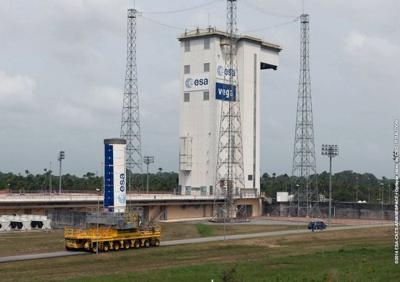Wed, Feb 19, 2014
Payload Will Be A Satellite For The Republic Of Kazakhstan
The launcher for Arianespace’s initial Vega flight of 2014 began its build-up this week at the Spaceport in French Guiana, marking the first step in a mission campaign that will lead to its orbiting of the DZZ-HR high-resolution observation satellite. To initiate the activity, Vega’s P80 first stage was transferred yesterday from the Spaceport’s Booster Integration Building to the SLV launch zone. It was then positioned on the launch pad and protected by the mobile gantry.

The P80 is an advanced solid propellant motor that features a novel filament-wound casing structure. Using one of the largest, most powerful single-block solid propellant motors ever built, the 33-foot tall stage burns for approximately 100 seconds during Vega’s first phase of flight.
This third Vega mission’s DZZ-HR payload is a satellite produced by Airbus Defense and Space for the Republic of Kazakhstan’s government. Once in Sun-synchronous orbit, DZZ-HR will provide very-high-quality panchromatic and multispectral products for a wide range of applications, including cadastral surveys, management of natural resources, environmental monitoring and homeland surveillance.
Vega is the light-lift member of Arianespace’s launcher family, joining the medium-weight Soyuz and heavy-lift Ariane 5 in operations at the Spaceport. Developed in a European Space Agency program led by Italy’s ASI space agency and industrial prime contractor ELV SpA., Vega was conceived for the orbiting of small- to medium-sized satellites, including institutional and scientific spacecraft.
The first Vega launch (designated Flight VV01 in Arianespace’s numbering system) was a qualification mission performed in February 2012, carrying the LARES laser relativity satellite, a small ALMASat-1 technology microsatellite demonstrator, and seven CubeSats. It was followed by Flight VV02 in May 2013, which orbited the Proba-V, VNREDSat-1 and ESTCube-1 satellites.
(Image provided by Arianspace)
More News
Its Offerings Are Lighter, Cleaner, and Now Pushing Past 1,000nm on SAF Jet Fuel DeltaHawk’s diesel-powered aircraft lineup has seen incredible upgrades over the last few yea>[...]
The Airplane Experienced A Total Loss Of Engine Power On December 3, 2025, about 1600 central standard time, a Mooney Aircraft Corp. M20K, N57229, was substantially damaged when it>[...]
Make Sure You NEVER Miss A New Story From Aero-News Network Do you ever feel like you never see posts from a certain person or page on Facebook or Instagram? Here’s how you c>[...]
Aero Linx: European Society of Aerospace Medicine (ESAM) As a pan-European, independent forum, it works to promote the safety and health of all persons involved in aviation and spa>[...]
“We are excited to see Wisk achieve this milestone, and I’m so proud of the team that made it possible. The team at Wisk has built advanced technologies across flight c>[...]
 Aero-TV: DeltaHawks Diesel Power Steps Into the Spotlight
Aero-TV: DeltaHawks Diesel Power Steps Into the Spotlight NTSB Prelim: Mooney Aircraft Corp. M20K
NTSB Prelim: Mooney Aircraft Corp. M20K ANN FAQ: Turn On Post Notifications
ANN FAQ: Turn On Post Notifications ANN's Daily Aero-Linx (12.20.25)
ANN's Daily Aero-Linx (12.20.25) Aero-News: Quote of the Day (12.20.25)
Aero-News: Quote of the Day (12.20.25)



